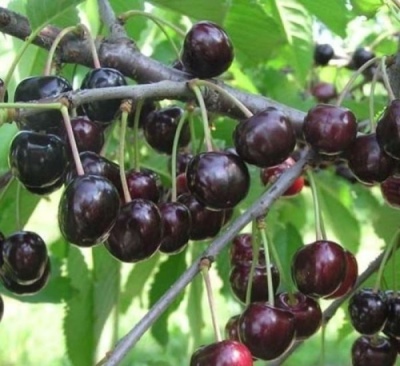
- Fruit shape: rounded
- Peduncle: short, medium thickness
- Authors: M.V. Kanshina, A.A. Astakhov, L.I. Zueva (All-Russian Research Institute of Lupine)
- Appeared when crossing: 3-14 x 3-36
- Year of approval: 2004
- Growth type: medium-sized
- Appointment: universal
- Yield: high
- Crown: pyramidal, medium density
- Escapes: straight, medium length and thickness, light brown
When choosing a cherry variety for growing in the middle lane, as well as in the south, it is recommended to pay attention to the Odrinka variety, which is considered one of the best in the list of stone fruit crops of domestic selection.
Breeding history
Late-ripening cherry Odrinka was created at the All-Russian Research Institute of Lupine. The authorship of the variety belongs to a group of scientists - V. M. Kanshina, L. I. Zueva and A. A. Astakhov. When crossing, two varieties were taken - 3-36 and 3-14. The tree was entered into the State Register in 2004. The fruit and stone fruit culture is zoned in the Central region.
Description of the variety
Odrinka is a medium-sized tree with a pyramidal crown, which is well thickened with dark green foliage. Sweet cherries have light brown, upright shoots, small buds tilted to the side, and a strong root system. On average, the tree grows up to 3 meters in height.
Blossoming at the tree later - falls on the last week of May. During this period, the cherry acquires an incredibly attractive appearance, covered with small snow-white flowers, collected in inflorescences of 3-4 pieces. The fruits are tied on a bouquet of twigs.
Fruit characteristics
This variety is large-fruited. On average, cherries grow in mass of 5.4-7.5 grams. The shape of the berries is correct - round, with a narrowed funnel and an oval top. At the stage of absolute ripeness, the berries have a dark red color, diluted with small subcutaneous dots of white in the center. The peel of the berries is thin, but elastic, thanks to which the cherries do not crack, dryly tear off the stalk.
The harvested crop endures long transportation, and can also be stored for 2-4 days in a cool place. Berries have a universal purpose - cherries are eaten fresh, frozen, processed into jams, compotes, and also massively used in cooking.
Taste qualities
The cherry taste is excellent. The dark cherry flesh is characterized by fleshiness, moderate density, tenderness and juiciness. The taste is dominated by sweetness, without astringency and sweetness, complemented by a dessert aroma. Burgundy juice is endowed with a rich and thick taste.
The rounded bone, which occupies about 6% of the volume, is easily separated from the cherry pulp. The pulp contains more than 11% sugars and less than 1% acids, in addition, cherries are rich in vitamins and minerals.
Ripening and fruiting
Odrinka is a late ripening variety. The tree begins to bear fruit in the 5th year after planting. You can taste the first berries at the end of July, and the peak of fruiting occurs in the first week of August. The cherries are spiced together, so the harvesting period is short.

Yield
Cherry yield indicators are excellent. If you provide proper care for the tree, it will certainly reward you with an excellent harvest. On average, you can count on 77 centners per hectare. The maximum indicator reaches 220-221 c / ha.
Growing regions
Cherry Odrinka is massively grown in the Krasnodar Territory and in Moscow. Recently, the geography of growth has expanded significantly - the cherry crop is grown in Moldova, Ukraine, Uzbekistan, as well as in Poland and Bulgaria. In addition, Odrinka is popular in Europe (with the exception of the northern part).
Self-fertility and the need for pollinators
Odrinka is self-fertile, therefore it needs pollinating trees. Productive pollinating varieties are Rechitsa, Revna and Ovstuzhenka. During the flowering period, it is recommended to spray with a honey solution to attract bees.
Growing and caring
For planting, a one-year or two-year-old seedling is purchased, which is best planted in the fall - a month before the onset of stable frosts. It is recommended to grow cherries in a clean area, where there is a lot of sun and light. Better if it is the southern or southwestern part, protected from cold winds and drafts.
Tree care is standard - watering, fertilizing from the second year of growth, plowing and weeding the soil, forming the crown, removing dry branches, mulching and preparing for winter.




Disease and pest resistance
The immune system of the variety is well developed. Cherry easily tolerates coccomycosis, and it is also resistant to moniliosis, clasterosporium, rust, scab, brown and gray rot. Sometimes cherries are attacked by insects - aphids, flies and weevils, which help to fight with insecticide treatments.

Requirements for soil and climatic conditions
Odrinka is frost-resistant, but during spring return frosts, about 15% of flowers can crumble. The tree also tolerates drought well, but watering must be controlled. The culture grows on fertile, moist and breathable soils with neutral acidity.Optimally comfortable cherries in loams, chernozems and sod-podzolic soils. It is important that the groundwater table is deep, otherwise excess moisture can damage the root system of the tree.
































































